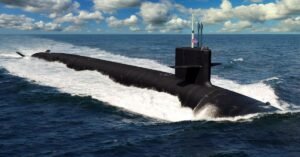The Ohio-class submarine is the longest in service with the U.S Navy and stands as a pillar of the country’s naval capabilities. This class is the largest ever built for the U.S Navy, designed during the Cold War era to boost America’s nuclear deterrence. It continues to play a vital role in maintaining the navy’s undersea dominance, both as ballistic missile submarines or SSBNs and in some cases as guided missile submarines or SSGNs.

Design
This class of submarines were conceived to offer a survivable, stealthy and persistent platform for launching nuclear weapons under the U.S Navy’s nuclear triad doctrine, alongside strategic bombers and land-based ICBMs.
The submarines were designed to have long endurance, reduced acoustic signature and the ability to carry a massive payload of Trident missiles, making each submarine a formidable asset.
Each submarine of this class is equipped with advanced noise-reduction capacity, including isolation of machinery, anechoic coatings and a specially designed hull to decrease sonar detection. The hull form and propulsion system were optimised for silent cruising, which is crucial for remaining undetected on long deterrent patrols.
Construction and Development
The General Dynamics Electric Boat Division in Groton, Connecticut, built the Ohio-class submarines.
The first submarine of the class, the USS Ohio or SSBN-726, was commissioned in 1981, followed by 17 more vessels.

Between 2002 and 2008, 4 submarines, namely Ohio, Michigan, Florida and Georgia, were converted from SSBNs to SSGNs, to shift their role from nuclear deterrence to strikes and special operations support.
The construction was not easy, and there were many challenges. Each submarine has hundreds of miles of wiring, advanced navigation systems and a control network to ensure fail-safe operation in hostile environments.
The Ohio-class is known for its flexibility, size and capacity. These submarines are 170.7 m long, making them the longest U.S submarines in service. They are 12.8 m wide and have a draft of 11.6 m and a displacement of around 18,750 tons submerged.
The submarine has a nuclear reactor and a shaft and can attain a speed of 20 knots when underwater. The submarine has a crew of 155 personnel, including 15 officers and 140 enlisted.
Their size allows them to have 24 vertical missile tubes, on SSBN variants and ample space for crew, equipment and provisions needed for missions lasting up to 90 days when submerged.
Armament and Role
The original task of the Ohio-class submarines was to function as ballistic missile submarines, having 24 Trident II D5 nuclear missiles.
Each missile can carry several independently targetable re-entry vehicles, increasing their striking capability. This makes even a single Ohio-class SSBN a powerful deterrent force capable of delivering devastating retaliatory strikes.
Four Ohio-class submarines were converted into guided missile submarines or SSGNs. In this configuration, the missile tubes were modified to hold 154 Tomahawk Land Attack Missiles.
These submarines also have lockout chambers for Navy SEALs and Spaces for Special Operations Forces support, including command centres, equipment bays, making them important to covert missions and power projection.
Operational Life and Strategic Importance
This class of submarines are manned by 2 alternating crews, Blue and Gold, to maximise the time at sea. This ensures a consistent strategic presence in major global areas without the downtime associated with single-crew operations.
These submarines spend at least two-thirds of their service life submerged, often in undisclosed patrol areas.
Their stealth and destructive potential provide a powerful deterrent against enemies and ensure second-strike capability in the event of a nuclear conflict.
Modernisation and Future Replacement
Though Ohio-class submarines were built to have a 30-year service life, most have been extended to 42 years through mid-life refuelling and upgrades. They are a major element of U.S strategic defence until they are replaced by the upcoming Columbia-class submarines, the first of which are expected to enter service in the early 2030s.
The Future Columbia-Class
The Columbia-class submarines are modernised successors to the Ohio-class. Each submarine will be 171 m long, similar to the Ohio-class, but with a slightly larger diameter, displacing around 20,800 tonnes when submerged.
The Columbia-class submarines will carry 16 Trident II D5LE ballistic missiles in vertical tubes, fewer than the Ohio class’s 24.
The missiles are upgraded and enhanced with improved guidance systems, ensuring effectiveness in the future.
General Dynamics Electric Boat is leading the construction of these submarines, along with Huntington Ingalls Newport News Shipbuilding.
The lead submarine of the class is the USS District of Columbia (SSBN‑826). Its keel was laid in 2022, and it is estimated to be delivered between 2028 and 2029, entering service and beginning patrols by 2030 and 2031.

The estimated budget for all 12 submarines was approximately 130 to 132 billion U.S dollars, with the lead submarine accounting for about 15.2 billion dollars and each subsequent one projected at about 8 to 9 billion dollars.
The project has faced many difficulties, including delays in fabrication, material shortage, especially turbines and supply chain problems, along with concerns regarding the quality of welding.
Given these issues, it is possible that there would be a 12 to 16-month delay for the first submarine’s delivery.
As the Ohio-class is retiring from 2028, the first Columbia submarine must enter waters by 2030 to avoid gaps in sea-based nuclear deterrence.
A total of 12 submarines are planned, and it is estimated that they will be completed by 2042 and are expected to remain functional into the 2080s.
You might also like to read-
- Types of Underwater Vehicles and Submarines
- Top 10 Biggest Submarines in the World
- How Deep Can Military Submarines Go?
- 5 Fastest Submarines in the World

